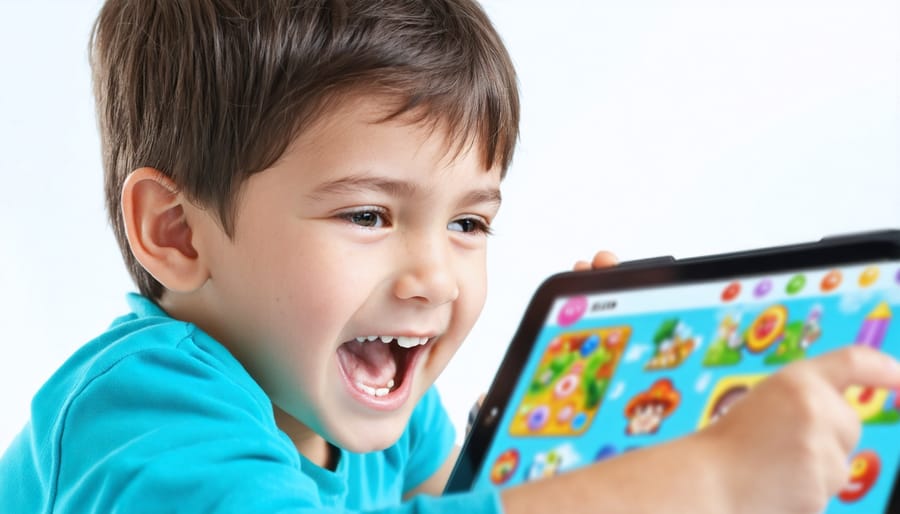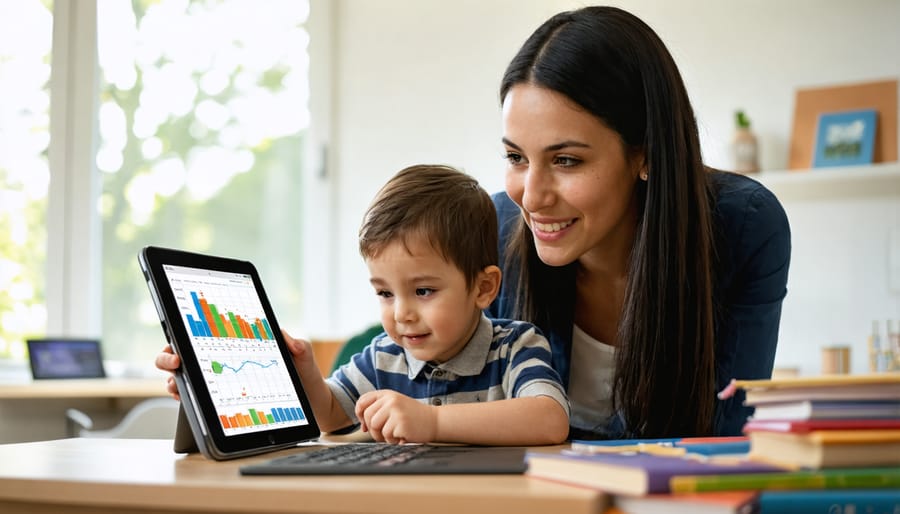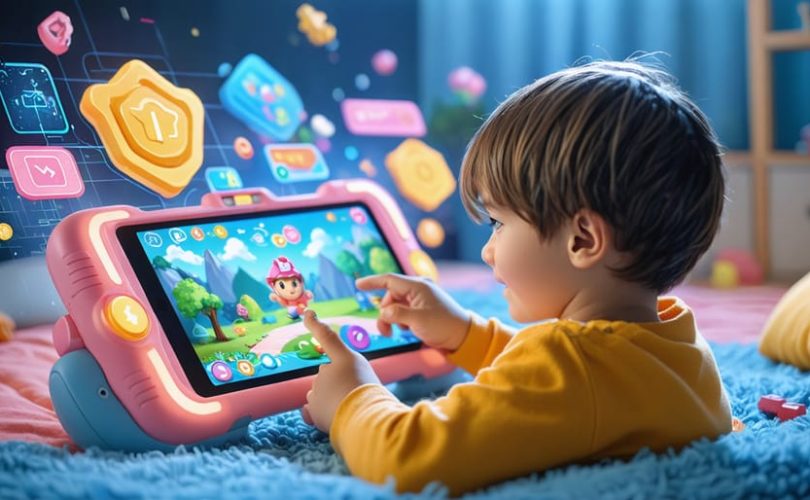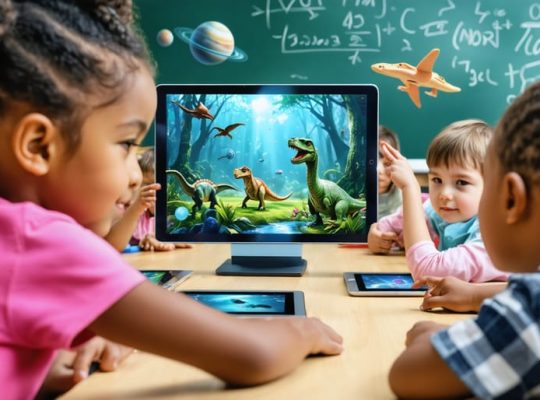Transform your child’s screen time into valuable learning experiences through the power of gamified education. In recent years, e-learning gamification has revolutionized how children engage with educational content, combining the natural appeal of games with structured learning objectives to create an immersive and effective educational environment.
Research shows that gamified learning platforms increase student engagement by up to 60% while improving knowledge retention by 40% compared to traditional methods. By incorporating elements like points, badges, leaderboards, and interactive challenges, these platforms tap into children’s intrinsic motivation to learn, explore, and achieve.
Parents and educators are discovering that gamification isn’t just about making learning fun – it’s about creating a dynamic educational ecosystem that adapts to each child’s unique learning style and pace. From mathematics and science to language arts and critical thinking skills, gamified platforms provide real-time feedback, celebrate progress, and maintain motivation through carefully designed reward systems.
As we navigate the digital age, understanding how to harness gamification’s potential becomes crucial for supporting our children’s educational journey. Whether you’re a parent looking to supplement classroom learning or an educator seeking innovative teaching methods, e-learning gamification offers a scientifically-backed approach to fostering academic success while nurturing a genuine love for learning.

Why Games Work Better Than Traditional Learning Methods
The Psychology Behind Learning Through Play
When children engage in play, their brains are actually hard at work, forming connections and processing information in ways that align perfectly with natural learning processes. Game mechanics tap into this innate learning system by triggering the release of dopamine, our brain’s reward chemical, which helps create positive associations with learning experiences.
Dr. Sarah Chen, a child development specialist, explains: “During gameplay, children enter a state of ‘flow’ where they’re fully engaged and receptive to new information. This state mirrors how we naturally learn best – through exploration, trial and error, and immediate feedback.”
The power of play-based learning lies in its ability to reduce stress while increasing motivation. When children face challenges in a game environment, they’re more likely to persist because the stakes feel lower, and the reward system keeps them engaged. This creates a positive feedback loop where effort leads to achievement, building confidence and resilience.
Games also provide safe spaces for experimentation and failure, essential components of deep learning. When children know they can try again without judgment, they develop a growth mindset that serves them well beyond their educational journey.
Benefits for Mental Well-being
Gamified e-learning provides a refreshing approach to managing academic anxiety by transforming potentially stressful learning experiences into enjoyable adventures. When children engage with educational content through game-like elements, they experience less pressure and more enthusiasm toward their studies.
Dr. Sarah Chen, a child psychologist, explains, “The playful nature of gamified learning helps children associate studying with positive emotions rather than stress. When they can ‘try again’ without harsh consequences, they develop a healthier relationship with learning.”
The reward systems in gamified platforms release dopamine, our brain’s feel-good chemical, creating positive associations with learning activities. This natural mood boost helps children maintain motivation while reducing the fear of failure that often accompanies traditional education methods.
Parents report that their children show increased confidence and reduced homework-related stress when using gamified learning platforms. Nine-year-old Tommy’s mother shares, “Since we started using educational games, homework time has become something he looks forward to instead of dreading. The difference in his emotional well-being is remarkable.”
Key Elements of Successful Learning Games
Progress Tracking and Rewards
Progress tracking in educational gaming platforms creates a powerful motivation system that keeps children engaged and excited about learning. When students can see their achievements displayed through progress bars, badges, and level-ups, they develop a stronger sense of accomplishment and ownership over their learning journey.
Think of it like climbing a mountain with clearly marked trails and viewpoints. Each small victory – whether it’s mastering multiplication tables or completing a challenging reading comprehension exercise – earns immediate recognition. This positive reinforcement triggers the release of dopamine, the feel-good hormone that encourages children to keep pushing forward.
Dr. Sarah Chen, an educational psychologist, explains: “When children receive instant feedback and rewards for their efforts, they’re more likely to develop a growth mindset. They begin to see challenges as opportunities rather than obstacles.”
Popular reward systems include:
– Virtual badges for completing lesson modules
– Point systems that unlock special features or characters
– Achievement certificates that can be shared with family
– Progress dashboards that visualize learning milestones
– Customizable avatars that evolve with advancement
Parents and teachers report that these tracking systems help children stay focused and motivated, especially during remote learning periods. The key is maintaining a balance where rewards enhance rather than overshadow the learning experience itself. When implemented thoughtfully, progress tracking transforms education into an exciting adventure where every step forward is celebrated.

Social Learning Features
Learning is inherently social, and successful e-learning gamification platforms recognize this fundamental aspect of human development. When children collaborate with peers in digital learning environments, they develop crucial social skills while reinforcing their academic knowledge.
Many gamified platforms now incorporate features like virtual study groups, team challenges, and peer-to-peer mentoring systems. For example, students can form “learning squads” to tackle complex problems together, sharing their unique perspectives and problem-solving approaches. This collaborative environment helps children build confidence while developing their communication and teamwork abilities.
Social learning features also tap into children’s natural desire for connection and friendly competition. Leaderboards, team achievements, and collaborative missions create opportunities for positive peer interaction, while carefully designed systems ensure that competition remains healthy and supportive rather than stressful.
Parents and teachers often notice that children who participate in social learning activities show increased motivation and engagement. As one elementary school teacher shares, “When my students work together on gamified projects, they’re not just learning the material – they’re teaching each other and building lasting friendships.”
These social elements can be particularly beneficial for children who struggle with traditional classroom interactions. The digital environment provides a structured, safe space where they can practice social skills at their own pace, gradually building confidence that often transfers to real-world situations.
To maximize these benefits, it’s important to guide children in using social features responsibly and maintaining a healthy balance between independent and collaborative learning activities.
Supporting Your Child’s E-Learning Journey
Creating a Balanced Learning Environment
Creating an engaging e-learning environment requires striking a healthy screen time balance while maintaining student motivation. Start by establishing clear boundaries and schedules that alternate between gamified learning activities and traditional offline tasks. A good rule of thumb is the 20-20-20 rule: after 20 minutes of screen time, take a 20-second break and look at something 20 feet away.
Consider implementing movement breaks between learning sessions to help children stay focused and energized. Simple exercises like stretching, jumping jacks, or a quick walk can make a significant difference in maintaining engagement. Dr. Sarah Chen, a pediatric occupational therapist, suggests, “Physical activity helps reset the brain and reduces the negative effects of prolonged screen time.”
To maximize engagement without overwhelming students, break learning sessions into smaller, manageable chunks. For younger children, aim for 15-20 minute gaming sessions, while older students can handle 30-45 minutes. Always monitor signs of fatigue or frustration, and adjust session lengths accordingly.
Create a dedicated learning space free from distractions, with good lighting and ergonomic seating. This helps students associate the area with focused learning time and makes transitions between activities smoother. Remember to incorporate regular hydration breaks and ensure proper posture during screen time.
Balance competitive elements with collaborative opportunities, allowing children to work together virtually while developing social skills. This approach helps maintain motivation while preventing excessive screen dependency. As one parent shared, “We found that mixing solo gaming with group challenges helped our daughter stay excited about learning while developing important social connections.”

Monitoring Progress and Providing Support
Tracking progress in gamified e-learning environments is crucial for ensuring effective learning outcomes and maintaining student engagement. Modern e-learning platforms typically offer comprehensive analytics dashboards where parents and educators can monitor various metrics, including completion rates, time spent on activities, and achievement levels.
Dr. Sarah Chen, an educational technology specialist, emphasizes the importance of regular progress checks: “It’s not just about tracking scores. Look for patterns in how children engage with different types of activities and when they’re most productive. This information helps us provide more targeted support.”
When monitoring student progress, focus on:
– Achievement of learning objectives
– Engagement levels and participation patterns
– Areas where students might be struggling
– Time management and pacing
– Social interaction in collaborative activities
Providing support should be proactive rather than reactive. Watch for early signs that a child might need additional help, such as declining engagement or avoiding specific types of activities. Remember to celebrate small wins and progress, as this reinforces positive learning behaviors.
Create a supportive environment by:
– Offering gentle guidance when needed
– Maintaining open communication about challenges
– Adjusting difficulty levels appropriately
– Providing positive reinforcement
– Setting realistic goals together
Many parents report success with regular “check-in” sessions where they discuss progress with their children in a casual, non-judgmental way. These conversations help identify any frustrations or challenges while maintaining enthusiasm for the learning journey.
Remember that every child progresses at their own pace, and the goal is to foster a love for learning rather than focusing solely on achievement metrics.
When to Seek Professional Guidance
While e-learning gamification can be highly effective, there are times when you might need to consult with education specialists or learning technology experts. If your child consistently shows frustration or disengagement despite gamified elements, this could indicate underlying learning challenges that need professional attention.
Watch for signs that the gamification elements are becoming more distracting than helpful. If your child focuses solely on earning badges or points while missing the educational content, it’s time to reassess the approach. Similarly, if they show anxiety about competition or become overly dependent on rewards, consider speaking with an educational psychologist.
Dr. Sarah Martinez, an educational technology specialist, explains: “When children spend excessive time on gamified platforms without making academic progress, or when their emotional well-being seems affected, that’s when professional guidance becomes crucial.”
Consider seeking help if you notice:
– Decreased interest in non-gamified learning activities
– Difficulty transitioning between gamified and traditional learning methods
– Signs of digital fatigue or screen addiction
– Declining academic performance despite increased engagement with gamified platforms
– Emotional outbursts when technology isn’t available
– Social withdrawal or preference for digital interactions over real-world connections
Educational consultants can help optimize gamification strategies for your child’s specific needs. They can recommend appropriate platforms, adjust difficulty levels, and ensure the right balance between entertainment and education.
Remember that seeking professional guidance isn’t a sign of failure – it’s a proactive step toward supporting your child’s educational journey. Many schools now have educational technology specialists who can assess whether current gamification methods are serving your child’s learning needs effectively.
If you’re an educator implementing gamification in your classroom, consider consulting with instructional designers when:
– Student engagement varies significantly across the class
– Technical issues consistently disrupt learning
– Assessment data shows uneven progress
– Students express confusion about learning objectives
– Game mechanics overshadow educational content
Professional guidance can help fine-tune your gamification strategy, ensuring it remains an effective tool for learning rather than a potential barrier to educational success.
As we’ve explored throughout this article, gamified e-learning represents a powerful transformation in how children engage with education. The combination of play and learning creates an environment where children naturally want to participate, leading to improved retention, increased motivation, and enhanced problem-solving skills. Parents who embrace this innovative approach often report seeing their children’s enthusiasm for learning grow exponentially.
The evidence is clear: when learning feels like play, children are more likely to stay focused, participate actively, and develop a genuine love for education. Through gamified platforms, they’re not just memorizing facts – they’re developing critical thinking skills, emotional resilience, and digital literacy, all while having fun.
Remember that you don’t need to be a technology expert to support your child’s gamified learning journey. Start small, be present, and celebrate their achievements along the way. Whether it’s completing educational quests, earning virtual badges, or progressing through learning levels, each milestone contributes to their academic and personal growth.
As technology continues to evolve, gamified learning will become increasingly integral to education. By embracing this approach now, you’re helping your child develop the skills they need for future success while fostering a positive relationship with learning. The key is to maintain a balanced approach, ensuring that gamified elements enhance rather than overshadow the educational content.
Let’s work together to create engaging, effective learning experiences that prepare our children for the digital age while preserving the joy of discovery.


